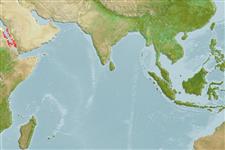Teleostei (teleosts) >
Blenniiformes (Blennies) >
Tripterygiidae (Triplefin blennies) > Tripterygiinae
Etymology: Enneapterygius: Greek, ennea = nine times + Greek, pterygion = little fin (Ref. 45335); qirmiz: Name from the Arabic word "Qirmiz" for deep red or crimson, referring to the colour of the species; noun in apposition.
Environment: milieu / climate zone / depth range / distribution range
Ecology
Marine; demersal; depth range 0 - 9 m (Ref. 88983). Tropical; 27°N - 13°N, 36°E - 43°E
Western Indian Ocean: Red Sea, Gulf of Aqaba, at Ras Mohammad and Ethiopia and off Yemen; the species is widespread, though not common in the Red Sea.
Size / Weight / Age
Maturity: Lm ? range ? - ? cm
Max length : 1.7 cm SL male/unsexed; (Ref. 88983)
Short description
Identification keys | Morphology | Morphometrics
Dorsal spines (total): 15 - 16; Dorsal soft rays (total): 9; Anal spines: 1; Anal soft rays: 17 - 18; Vertebrae: 33 - 34. This species is distinguished by the following characters: small sized with a maximum recorded SL of 25.3 mm; D1 III, D2 XII-XIII, D3 9, first dorsal fin about the same height as the second; A I,17; pectoral fin 14; nape scaled; both sexes with characteristic oval patch of melanophores on dorsum between third and fourth dorsal-fin spines, males with large rectangular blotch of melanophores and brown pigment on side below posterior of second dorsal fin; red in life, with first dorsal of males crimson in front with golden yellow marks, white behind, base of fin a white patch on dorsum (Ref. 88983).
Adults are found in environments very similar to E. obscurus. They also commonly occur in isolated reefs far from coasts wherein other Enneapterygius spp. could not be found (Ref. 88983). Eggs are hemispherical and covered with numerous sticky threads that anchor them in the algae on the nesting sites (Ref. 240). Larvae are planktonic which occur primarily in shallow, nearshore waters (Ref. 94114).
Life cycle and mating behavior
Maturity | Reproduction | Spawning | Eggs | Fecundity | Larvae
Holleman, W. and S.V. Bogorodsky, 2012. A review of the blennioid fish family Tripterygiidae (Perciformes) in the Red Sea, with description of Enneapterygius qirmiz, and reinstatement of Enneapterygius altipinnis Clark, 1980. Zootaxa 3152:36-60. (Ref. 88983)
IUCN Red List Status (Ref. 130435: Version 2024-1)
Threat to humans
Harmless
Human uses
Fisheries: of no interest
Tools
Special reports
Download XML
Internet sources
Estimates based on models
Preferred temperature (Ref.
123201): 27.8 - 29.3, mean 29 °C (based on 91 cells).
Phylogenetic diversity index (Ref.
82804): PD
50 = 0.5000 [Uniqueness, from 0.5 = low to 2.0 = high].
Bayesian length-weight: a=0.00955 (0.00304 - 0.03005), b=3.02 (2.77 - 3.27), in cm total length, based on LWR estimates for this (Sub)family-body shape (Ref.
93245).
Trophic level (Ref.
69278): 3.0 ±0.3 se; based on size and trophs of closest relatives
Fishing Vulnerability (Ref.
59153): Low vulnerability (10 of 100).
